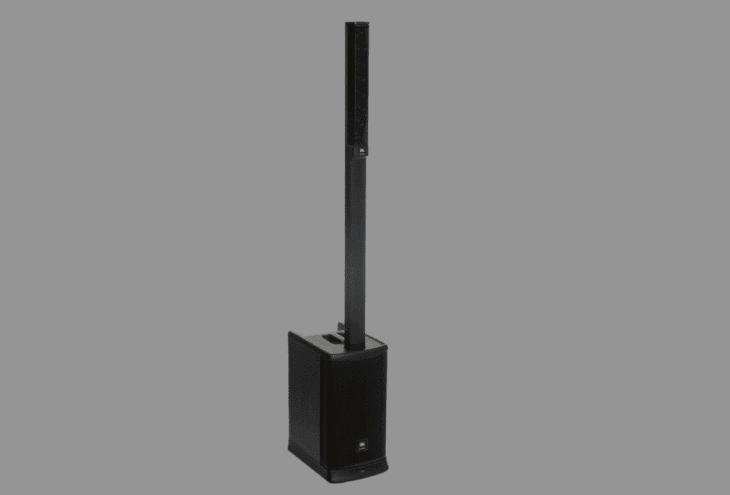For the solo artist, a well-chosen all-in-one PA system can mean the difference between a compelling live show and a forgettable performance. Whether you’re playing a coffeehouse, a farmers market, or a small venue, controlling your own sound is both empowering and essential. Fortunately, today’s market offers plenty of budget-friendly, compact PA systems from QSC, JBL, and Mackie that combine portability with surprising power and clarity. But great gear alone won’t carry your performance—understanding how to set gain, avoid feedback, apply reverb tastefully, and properly place your speakers is just as important.
Choosing the Right All-in-One System
Today’s singer-songwriters have access to an impressive range of portable PA systems that deliver clarity, power, and reliability—without blowing the budget. Many of these solutions are compact, battery-powered, and designed for ease of use in solo performance settings. Models from brands like QSC, JBL, and Mackie offer great examples of how far all-in-one PA technology has come.
QSC KC12: Premium Performance in a Column Format
For singer-songwriters looking for professional-grade sound in a column-style PA, the QSC KC12 is a standout. This three-way active loudspeaker combines a 12-inch subwoofer, dual four-inch midrange drivers, and a one-inch compression driver—powered by a 3000-watt Class D amp. The result is detailed, full-range sound from 45 Hz to 18.5 kHz with wide, even dispersion thanks to QSC’s proprietary LEAF™ waveguide (145° horizontal, 35° vertical).
What makes the KC12 especially appealing for singer-songwriters is its flexibility. It features two XLR combo jacks that support mic, line, and Hi-Z signals, allowing users to plug in a guitar and mic directly—no mixer required. A digital display lets you dial in EQ, presets, delay, Bluetooth settings, and even onboard reverb. With True Wireless Stereo and Bluetooth streaming, backing tracks are easy to integrate. And at 60 pounds, it’s portable enough for most gigging musicians. With rugged ABS housing and a six-year warranty, the KC12 is built to last.
JBL EON ONE MK2: True All-in-One Versatility
JBL’s EON ONE MK2 is a fully self-contained column PA system ideal for street performers, café artists, or anyone needing battery power. It features a 10-inch woofer and eight two-inch tweeters in a C-shaped array for 140° x 30° dispersion. The system can output up to 123 dB SPL on AC power (119 dB on battery), which is plenty for most solo gigs.
A built-in five-channel mixer includes three XLR combo jacks, Hi-Z input, 3.5mm aux, and Bluetooth 5.0 streaming. Artists can access Lexicon reverb, delay, and chorus effects, as well as dbx DriveRack processing, automatic feedback suppression (AFS), and an eight-band EQ—all controllable via the JBL Pro Connect app. At just 42.5 pounds with a six-hour lithium-ion battery, the EON ONE MK2 is as portable as it is powerful. The Soundcraft Easy Ducking feature automatically lowers background music when you speak—handy for announcements or between-song banter.
Mackie Thump GO: Affordable and Lightweight
Mackie’s Thump GO is one of the most affordable battery-powered PA systems in this category, offering simplicity and convenience for solo performers on the go. Weighing under 20 pounds, it features a two-channel mixer, 200 watts of Class D amplification, an eight-inch woofer, and a one-inch compression driver. It delivers a maximum SPL of 115 dB and covers a frequency range of 50 Hz to 20 kHz—ideal for small to medium spaces.
Bluetooth audio streaming and wireless control via the Thump Connect 2 app allow you to manage levels, EQ, and voicing modes from your phone. There are four onboard EQ presets—Music, Live, Monitor, and Sub—to quickly adapt to different venues. A built-in feedback eliminator and up to 12 hours of battery life make this a plug-and-play favorite for acoustic gigs, busking, or outdoor performances.
Gain Structure: Getting It Right from the Start
Gain staging is a critical step in getting your PA system to sound clean and powerful. The gain (or trim) knob sets the input sensitivity for each channel. If it’s set too low, your signal will be weak and noisy. Too high, and you risk distortion or feedback.
To dial it in, start with your channel level at unity (typically labeled 0). Then raise the gain while you sing or play your loudest passage, watching the input meter or clip indicator. Aim for a signal that peaks around -6 dB. Always set gain based on your loudest moments to maintain headroom and prevent overload.
Avoiding Feedback in Small Rooms
Feedback is one of the most common—and frustrating—issues in small live sound environments. The high-pitched squeal occurs when a microphone picks up its own signal from the speaker and loops it. Thankfully, good placement and a little know-how can prevent it.
Position your speakers in front of your mic and angled away from you, especially in reverberant or reflective spaces. Avoid putting speakers behind your mic unless your PA includes strong feedback suppression. Use cardioid-pattern mics to reduce room bleed. If your system offers notch filtering or a feedback eliminator—like the Mackie Thump GO and JBL EON ONE MK2—turn it on early, not after feedback starts.
Lowering your mic gain slightly and raising the speaker’s main output volume can also help reduce the chance of a feedback loop.
Reverb and Compression: Less is More
Most modern all-in-one PAs include basic effects—primarily reverb, with occasional options for compression or delay. Reverb adds ambiance, but too much—especially in a live room—can muddy your vocals. Stick with short hall or plate settings and keep levels modest.
Compression helps balance dynamics, particularly useful for vocalists with wide dynamic range. If your PA doesn’t offer onboard compression, consider a pedal or preamp with light compression (2:1 or 3:1 ratio). Be careful not to overdo it; excessive compression can rob your performance of expression and nuance.
Room Placement and Acoustic Awareness
Speaker placement can make or break your sound. Always elevate your speakers to ear level and tilt them slightly downward to minimize reflections. Ground-stacked speakers can sound boomy and unclear, especially in crowded rooms or corners.
In small, untreated rooms, rolling off some low end using onboard EQ can tighten up your mix. Many systems have preset voicings such as “Speech” or “Music.” For acoustic sets, “Speech” often improves vocal clarity, especially in noisy spaces.
Outdoors, you’ll need more output to compensate for lack of walls and reflections. Consider running two units in stereo or pairing your main PA with a compact sub if you use backing tracks or looped percussion.
Final Soundcheck Tips
Many all-in-one PAs also serve as front-ends for livestreaming or recording. Both the JBL and Mackie systems offer line outs or Bluetooth streaming, making it easy to capture performances. Before every show, do a quick soundcheck and record a snippet—even using your phone—to hear what the audience will hear.
If you’re looping, running effects, or using backing tracks, make sure to test your entire signal chain. Don’t assume levels will be right just because they were yesterday.
In Closing: Your songs and performance are what matter most, but a solid, well-set-up PA helps ensure those songs are heard with the clarity and emotion you intended. Whether you’re looking at the refined power of the QSC KC12, the smart versatility of JBL’s EON ONE MK2, or the grab-and-go ease of the Mackie Thump GO, there’s never been a better time to build a portable, pro-level rig that works as hard as you do.














